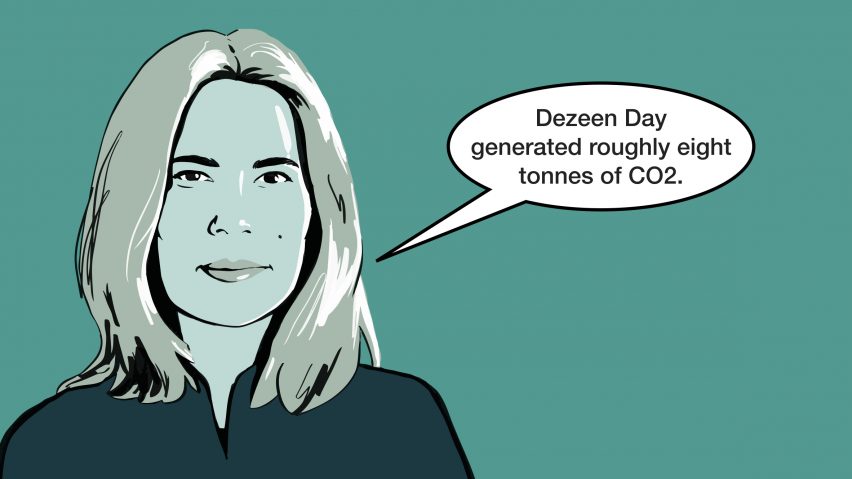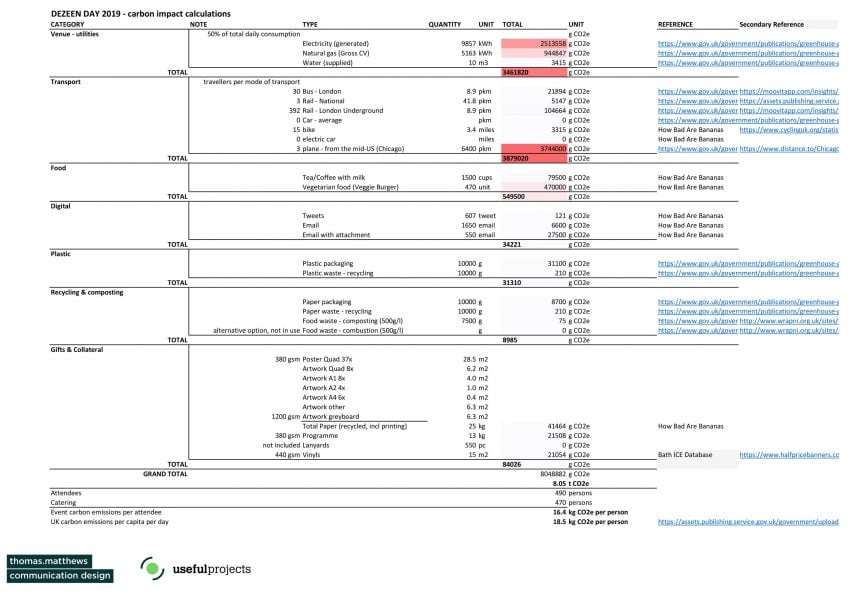
Environmental audit reveals the carbon footprint of Dezeen Day conference
Dezeen Day generated eight tonnes of carbon emissions, according to a "quick and dirty" environmental audit of the conference by Sophie Thomas.
Thomas, an environmental designer who attended the day-long conference last month, investigated the environmental impact of the event.
Using a mixture of data from Dezeen, observations made on the day and best estimates, Thomas scored the conference for its environmental performance.
"Having spent the day observing eating habits, talking about how people travelled, talking to the chef and venue managers and poking around the bin store I got a very rough snapshot of the impact of Dezeen Day last week," Thomas said.
"In total, we estimate that over nine hours Dezeen Day generated roughly eight tonnes of CO2e."

CO2e is carbon dioxide equivalent, which is the standard way of measuring carbon footprints. Different greenhouse gases give different warming effects, so the CO2e standard converts these different impacts into a single measure that represents the amount of CO2 that would cause a similar warming effect.
The carbon footprint of each attendee is therefore 16.4kg CO2e for the nine-hour period, compared to the average UK per-capita figure of 18.5kg CO2e per day. This means that per-capita emissions were roughly three times as high as if they'd not come to the conference.
Thomas added that this calculation is "heavily caveated" since it is based on averages such as the amount of hot beverages consumed by conference goers, the emissions generated by people flying to the event and the source of the energy used at the venue.
Transport, electricity, gas, water and food biggest causes of emissions
Thomas, a partner at London environmental communication-design studio Thomas.Matthews, spent the day at the conference and presented her initial findings on stage at the end of the day.
She then submitted a more detailed report on the event, with recommendations for future improvements. The report was co-written by Ralf Waterfield of the Useful Simple social enterprise trust.
According to Thomas the three biggest causes of emissions were transport (3.7 tonnes of CO2e), use of electricity, gas and water at the venue (3.4 tonnes of CO2e) and food (0.5 tonnes of CO2e).
In addition coffee and tea consumption accounted for 79kg of CO2e, tweets sent by Dezeen's social-media team generated 120g, emails with attachments caused 27.6kg and the programme, which was printed on post-consumer recycled paper, was responsible for 12.5g of carbon.
BFI Southbank "a good central location"
The location of the conference scored highly, since BFI Southbank is served by numerous bus, Tube and train services and has good pedestrian links. A show of hands at the conference indicated that almost all attendees had arrived by public transport.
"The Dezeen team chose a good central location, even before they committed to this audit process," Thomas said. "The BFI is signed up to Culture Declares Emergency, has four beehives on its sites and a zero-to-landfill policy in place. It says it will be refreshing its recycling policy and stopping the purchase of single-use plastic."
"It's clear that the venue's electricity consumption and air travel make up the bulk of emissions," said Thomas. Three of the conference speakers flew from the USA to the event, while the rest of the speakers either lived in London already, or came by train.
"In our calculations, food, which was modelled on an equivalent, was the fourth biggest emitter and more significant than all transport, other than air travel," she said, adding that catering waste was high due to food being ordered for attendees who didn't show up.
"Food waste is only relevant because of over-ordering, not because of the emissions associated with dealing with the organic waste itself," Thomas said.
Dezeen minimised conference's environmental impact
Dezeen worked hard to minimise the conference's environmental impact, serving tap water instead of bottled water, providing a meat-free lunch and encouraging attendees to use public transport or come on foot or by bicycle.
We almost managed to eliminate single-use plastic. Conference lanyards were made of recycled card and unbleached cotton; attendees were given Hershel backpacks with lifetime warranties instead of cotton tote bags.
"You would need to re-use a cotton tote bag 131 times to bring its impact down to the same level as a single-use plastic equivalent," Thomas observed.
"You said no to bottled water and single use packaging, although the crisps got through," she added, referring to the fact that packets of potato crisps with un-recyclable packaging were served for lunch.
"Saying no to bottled water and offering tap water made an impact," Thomas said. "Bottled water would have had 1,000 times more impact than the tap water drunk."
Dezeen Day could improve impact of catering
Catering was the area where Thomas felt we could make the most improvement. Almost ten per cent of attendees failed to show up, meaning the food allocated for them went to waste. The dropout rate had been expected and Dezeen oversold conference tickets to compensate, but catering was still provided for no-shows.
The sandwiches ordered for lunch were not made at the on-site kitchen but prepared in Bermondsey and placed in single-use cardboard and plastic packaging, which was then thrown away when the time came to serve them on trays.
This "slightly defeated the point of the team trying to rule out single-use packaging," Thomas said.
Thomas praised the decision to serve vegetation food. "The impact from vegetarian food is roughly 60 per cent lower than from meat-based equivalents, so the Dezeen team are already moving in the right direction," she said.
"Next year maybe try a no-dairy, vegan event and be mindful that one cappuccino drunk in the speakers' VIP room is five times the CO2e of a filter cup served to everyone else."
A livestream could allow overseas people to participate without flying
Other recommendations included providing a livestream so people overseas can participate without having to fly to London, and choosing a venue that is supplied by renewable energy.
"You were brave to ask me to come and do a quick and dirty audit on the event to see if it is possible to do a carbon neutral day (no, sorry, not possible)," Thomas wrote in her report.
"But an event is so much more than this: inspiration, new ideas, collaboration, better understanding and networking, all things that are very hard to measure."
Topics discussed at the conference included designing for the circular economy and sustainable materials.
She concluded that if Dezeen Day is able to change people's behaviour, it will have been worthwhile, despite its carbon emissions.
"The event could have a positive impact before, during and after it takes place," she said. "Repetition is the key to turn a behaviour change into a habit and since an event like Dezeen Day has direct contact with its audience on multiple occasions over the course of several months and years, this might the most powerful intervention to reduce carbon emissions."
"Scientists, governments, institutions and citizens have called a climate emergency. We have no more time left for chipping at the edges. The time is now for action and the design sector cannot sit by and shrug, not knowing what to do."
Overall Thomas gave Dezeen Day a score of 72 out of 100 for its sustainability, based on the understanding that uses its influence to "help attendees to change their carbon guzzling ways of designing".
Illustration is by Rima Sabina Aouf.
